- Premium features included
- No hidden costs or usage limits
- Scale from startup to enterprise


Back in 2004, two Australian entrepreneurs—Ben Richardson and David Greiner—started what’s now one of the bigger email marketing tools around. They bootstrapped the whole thing, no outside funding, just steady growth year after year.
These days, Campaign Monitor operates out of Nashville and serves something like 250,000 Campaign Monitor users. We’re talking everyone from tiny startups to brands like Coca-Cola and Disney. They’re pushing billions of emails monthly, and their deliverability rates are solid. That said, there’s more to my Campaign Monitor review.
Campaign Monitor is an email marketing solution that manages to be both sophisticated and easy to use. I’ve been using it for client email marketing campaigns for a while now, and the drag-and-drop builder just works, while templates look professional and are mobile-responsive without any tweaking needed.
The segmentation capabilities are where things get interesting—you can slice and dice your audience using behavioral data, custom fields, whatever you need. It connects with all the usual suspects (Salesforce, Shopify, WordPress), and when something goes wrong, their support team knows what they’re talking about.
Yeah, it’s pricier than some Campaign Monitor alternatives, but for design-conscious brands and agencies juggling multiple clients, the extra cost makes sense.
The first thing I noticed about Campaign Monitor email campaigns workflow was how it catches mistakes before they go live. That Link Review feature? It’s saved my bacon more times than I can count. It scans for broken links, missing URLs, or those embarrassing moments when you duplicate a campaign and forget to update the links.
The Design & Spam testing is another lifesaver. You can preview how your email renders across different clients and catch anything that might trigger spam filters. Dynamic content rules (IF/ELSE conditions and such) mean you can send one campaign with varying blocks of content for different segments.
Quick heads up: the preview text (that little snippet after the subject line) gets added at send time, so don’t panic if you don’t see it in your preview.
The visual email builder works in sections—add what you need, adjust spacing and layout from the sidebar. Simple enough.
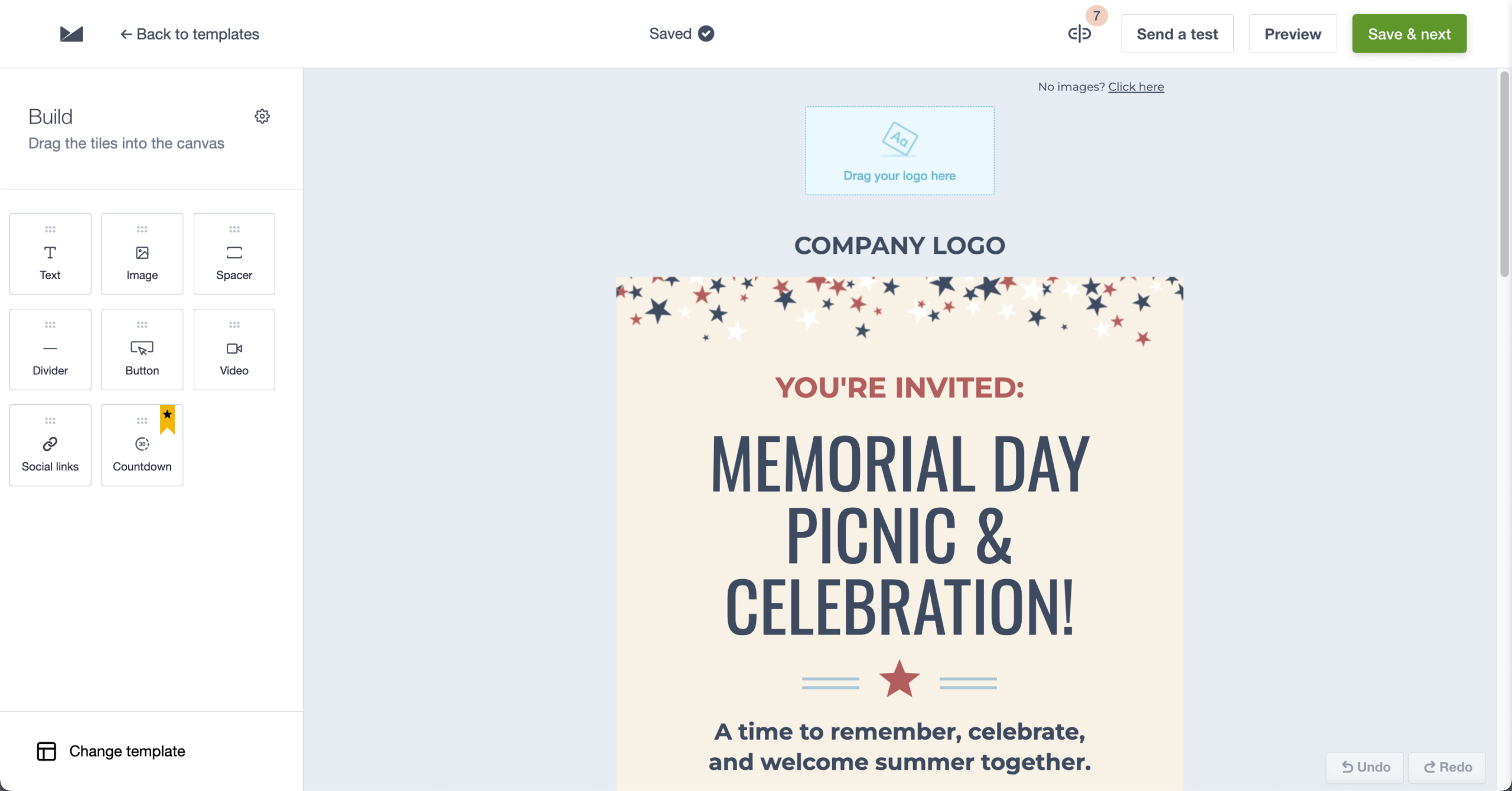
What I really appreciate are the little touches. There’s an image gallery built right in (millions of Unsplash photos), so no more hunting for stock photos in another tab. The mobile controls are particularly clever—for each section, you decide whether columns should stack, reverse-stack, or stay side-by-side on mobile devices.
You can add phone and SMS links that work on mobile. Click the number, it dials. Click the SMS link, it opens their messaging app. Small detail, big impact for local businesses.
If you’re comfortable with HTML, Campaign Monitor’s email template customization language goes pretty deep. You’ve got `<repeater>` blocks for content that needs to repeat (think article lists or product grids), and you can create different layout options that content creators can choose from within the template library.
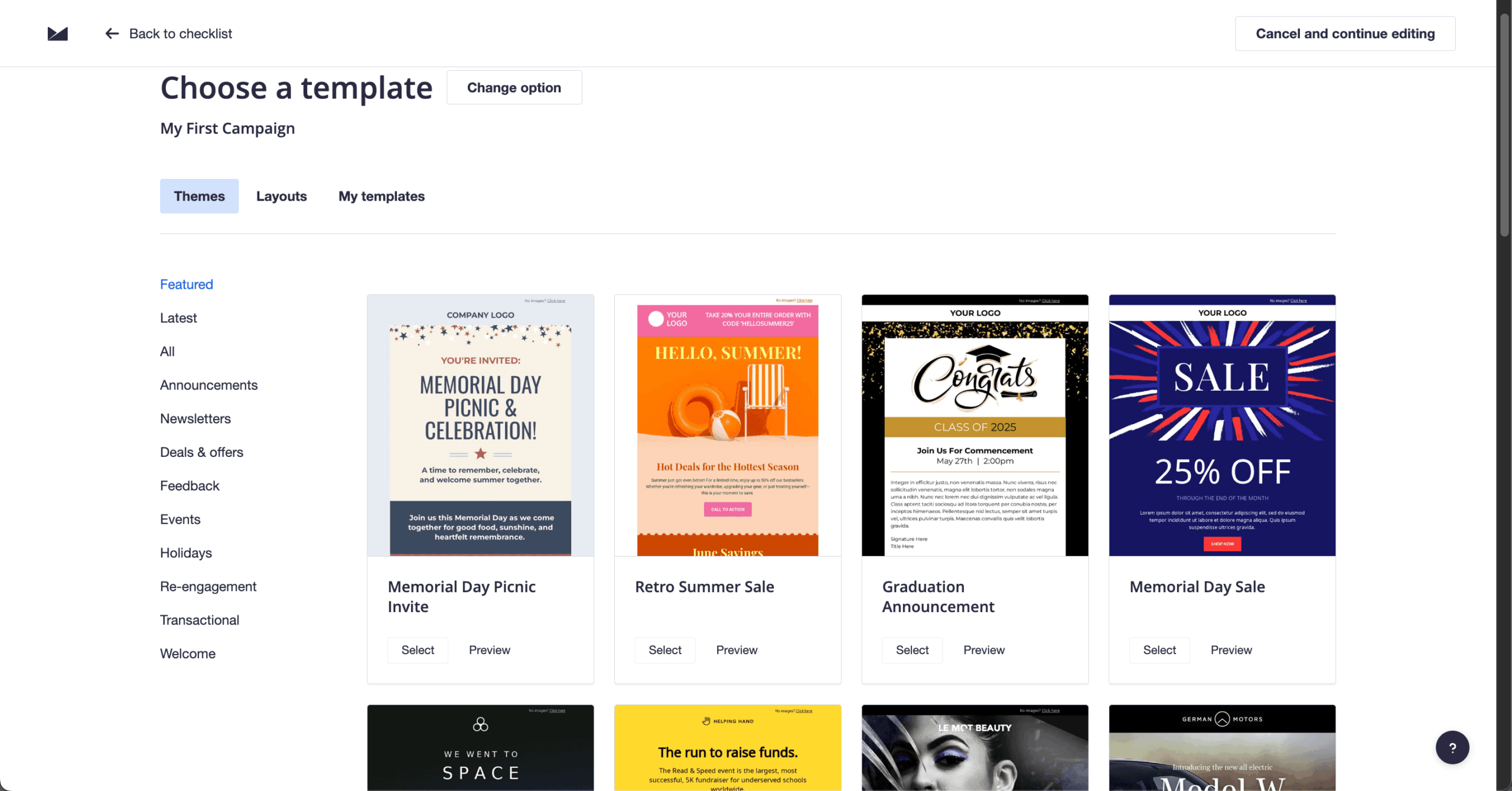
Images that are marked as editable will auto-resize when uploaded, which keeps non-technical users from breaking layouts with massive images. You can generate tables of contents automatically, disable tracking on specific links, control whether images get imported—lots of granular control if you need it in your HTML template.
Got a desktop design with alternating image-text-image-text layouts? On mobile, that can look weird. With Campaign Monitor, you can reverse the stacking order so it flows naturally on phones. Background images can be set to their original size or fitted to sections, and there’s a focal point selector to prevent important parts from getting cropped for professional email design.
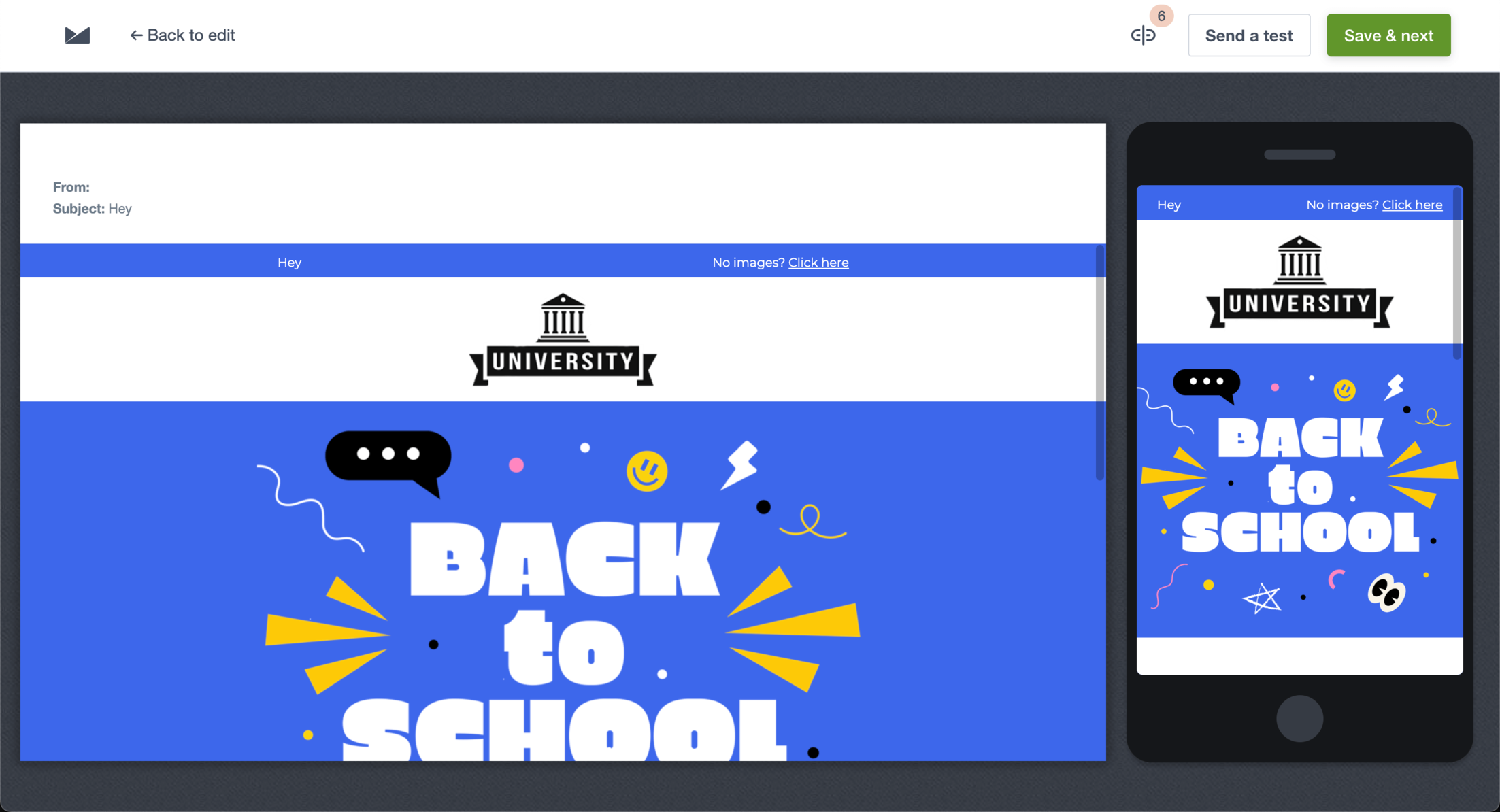
I’ve built tons of automated journeys in Campaign Monitor, and while it’s not the most complex automation builder out there, it handles 90% of what most businesses need for their marketing automation. For teams needing more sophisticated automation at a better price, Sender delivers more bang for your buck.
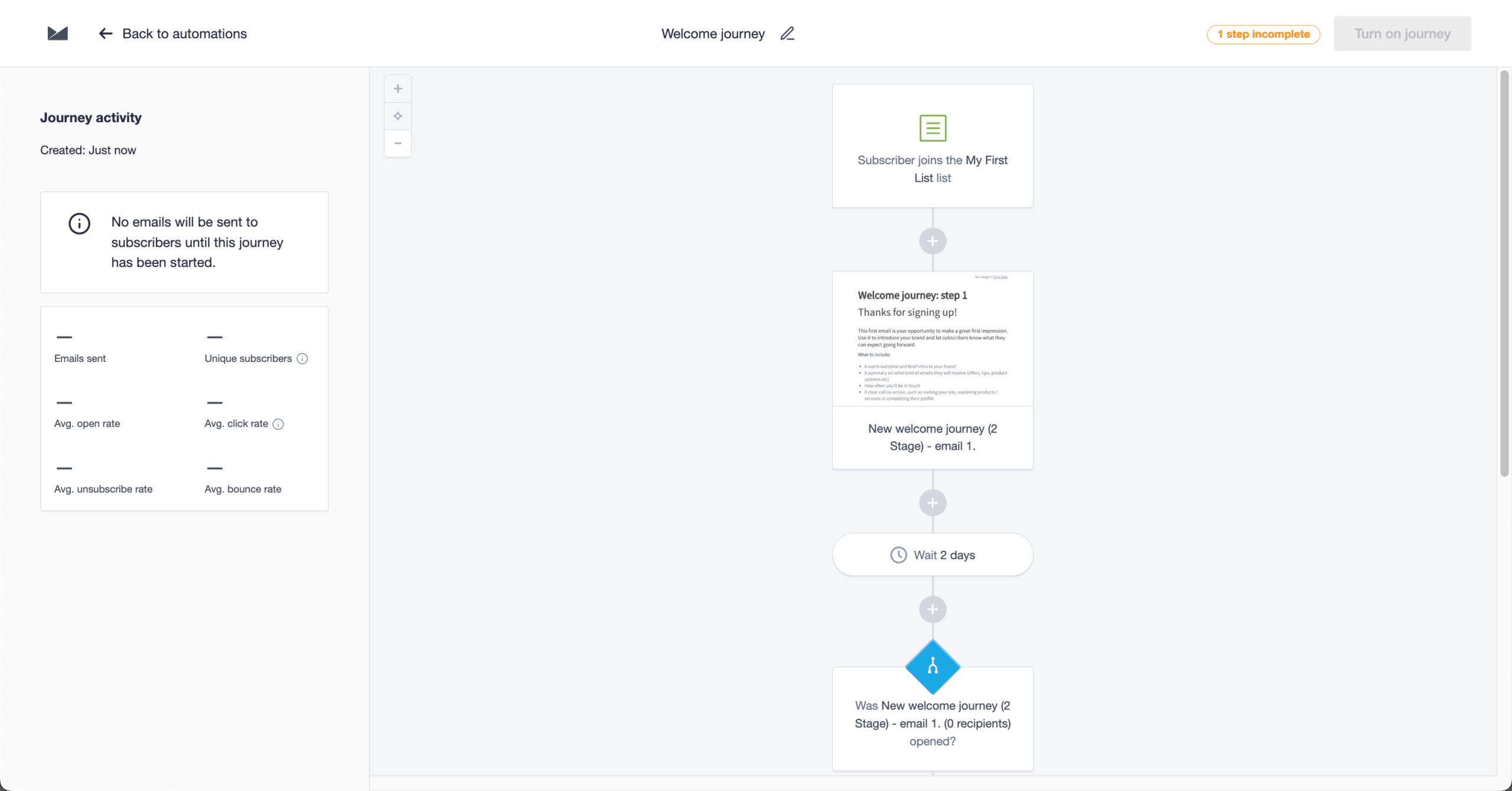
You work with five basic building blocks: Email, Delay, Wait until, Condition, and Custom field. The Wait-Until feature is particularly useful—you can hold automated emails until weekdays only, avoiding those weekend sends that just get buried.
For one client’s loyalty program, I used the Custom field step to increment point counters right in the automation flow. No external database needed. The API lets you copy entire subscriber journeys between accounts, which speeds up agency work considerably. Each custom journey can be tailored to different segments of your audience.
Campaign Monitor handles transactional emails two ways. Smart emails are built in the app and triggered with recipient data. Classic emails mean your application sends the full HTML. You can trigger emails based on user actions or system events.
Both methods work via API or SMTP. Messages automatically inherit your domain authentication settings, and tracking is on by default (though you can disable it for specific links). CSS gets inlined automatically for better email client compatibility.
A/B testing covers the basics: subject lines, from names, or complete content variations. For advanced split testing, you set how many people see the test and for how long, then the system picks the winner and sends it to everyone else.

There’s a subject line history feature that shows what you’ve tested before, and you can quickly reuse winning variations. I always run tests alongside spam checks and schedule sends by timezone to reduce variables. You can test different email versions to see what resonates with your audience.
The limitations are real, though. No multivariate testing, no A/B/C options, and you can’t split test within automation sequences (you’d need to build parallel journeys for that).
The form builder covers your basics: embedded forms, pop-ups, and hosted landing pages. Each form connects to a list and can use single or double opt-in for new subscribers. You can create standalone forms that work independently or embeddable forms for your website.
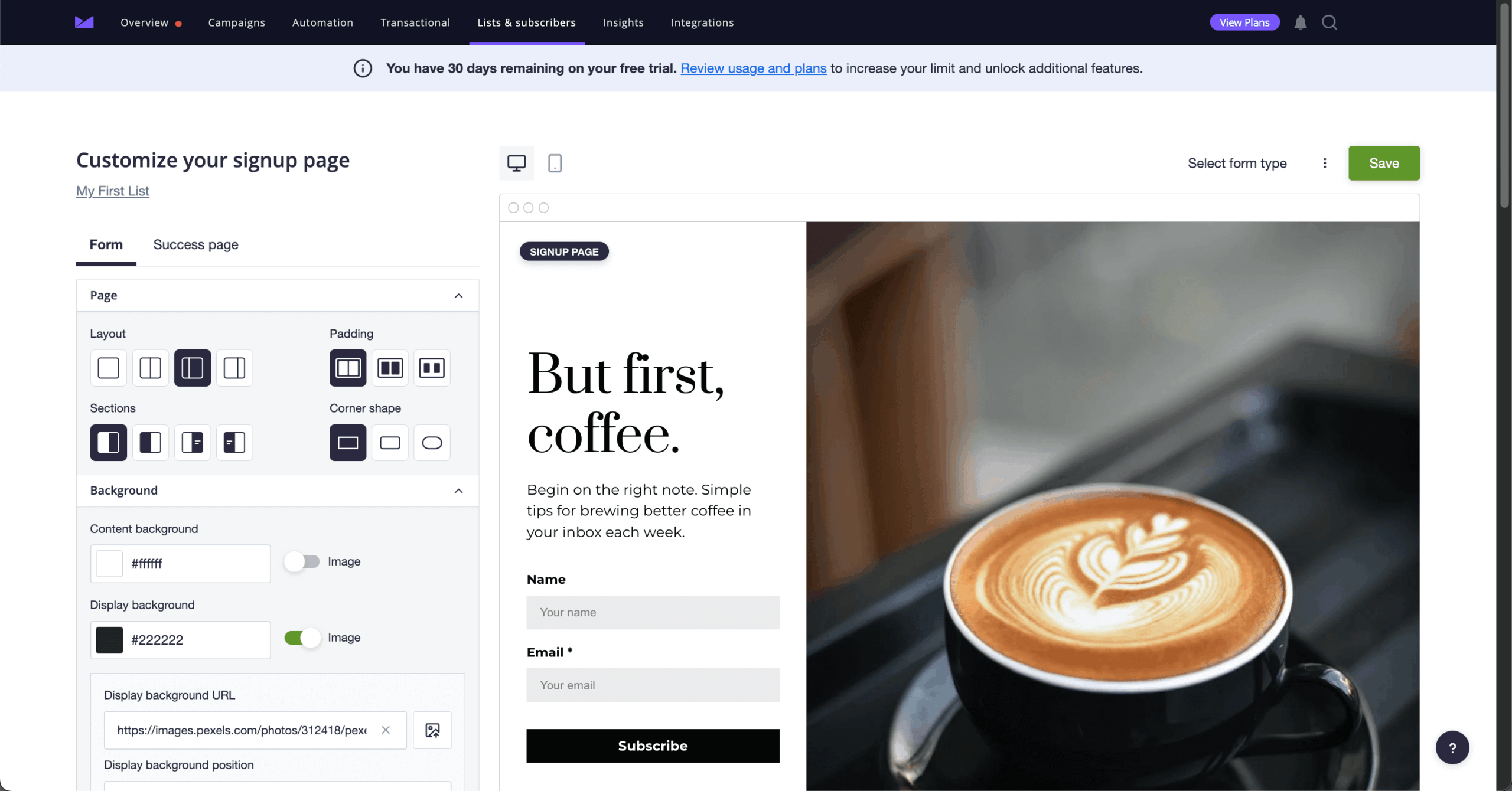
The limitations become obvious pretty quickly. No multi-step forms, basic pop-up targeting (no exit intent or scroll triggers), and zero A/B testing capability. Bot protection is minimal, too. For sites with spam problems, I usually recommend adding reCAPTCHA through a third-party form tool.
Campaign Monitor uses lists rather than a single database. The big advantage: you can set unsubscribes to affect just one list or all lists—crucial when you’re running multiple newsletters. It supports various common database formats for easy importing.
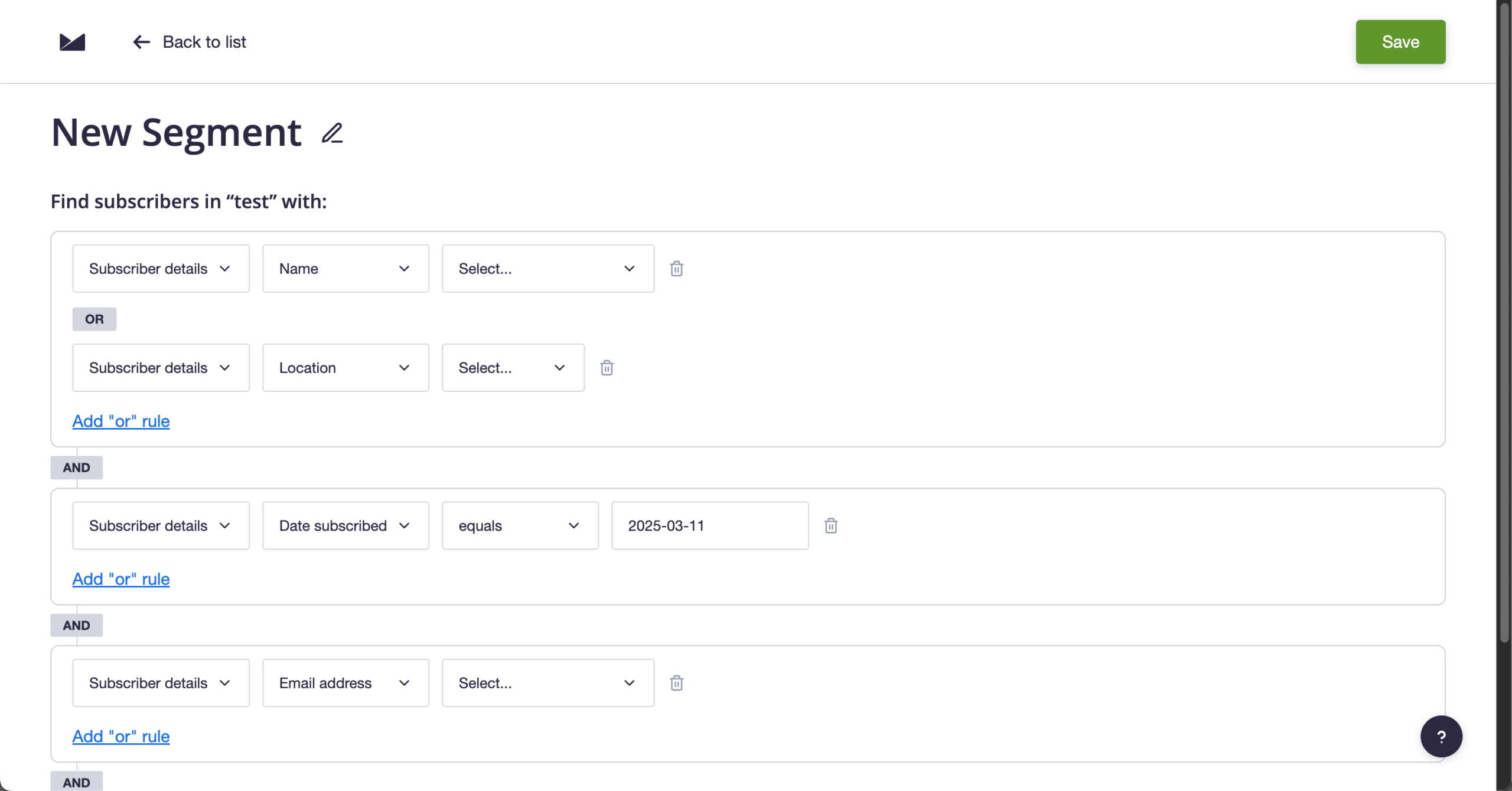
Custom fields handle all the standard data types, plus country and state fields with built-in validation. The Preference Center lets subscribers update their own info, and there’s a global suppression list to prevent accidentally re-adding unsubscribes. This gives you detailed insights into your user journey.
Email list segmentation logic is flexible enough for most needs. You can use OR within rule groups and AND between groups. So “engaged in the last 30 days” AND (“lives in California” OR “lives in New York”) AND “purchased in 2024” is totally doable. The interface maintains its user friendliness even with complex segments.
Email integration options covers the essentials: Shopify, WooCommerce, BigCommerce for ecommerce; Salesforce for CRM; WordPress for content. For everything else, there’s Zapier and Make. The sales team can easily navigate between Campaign Monitor and their CRM without missing a beat.
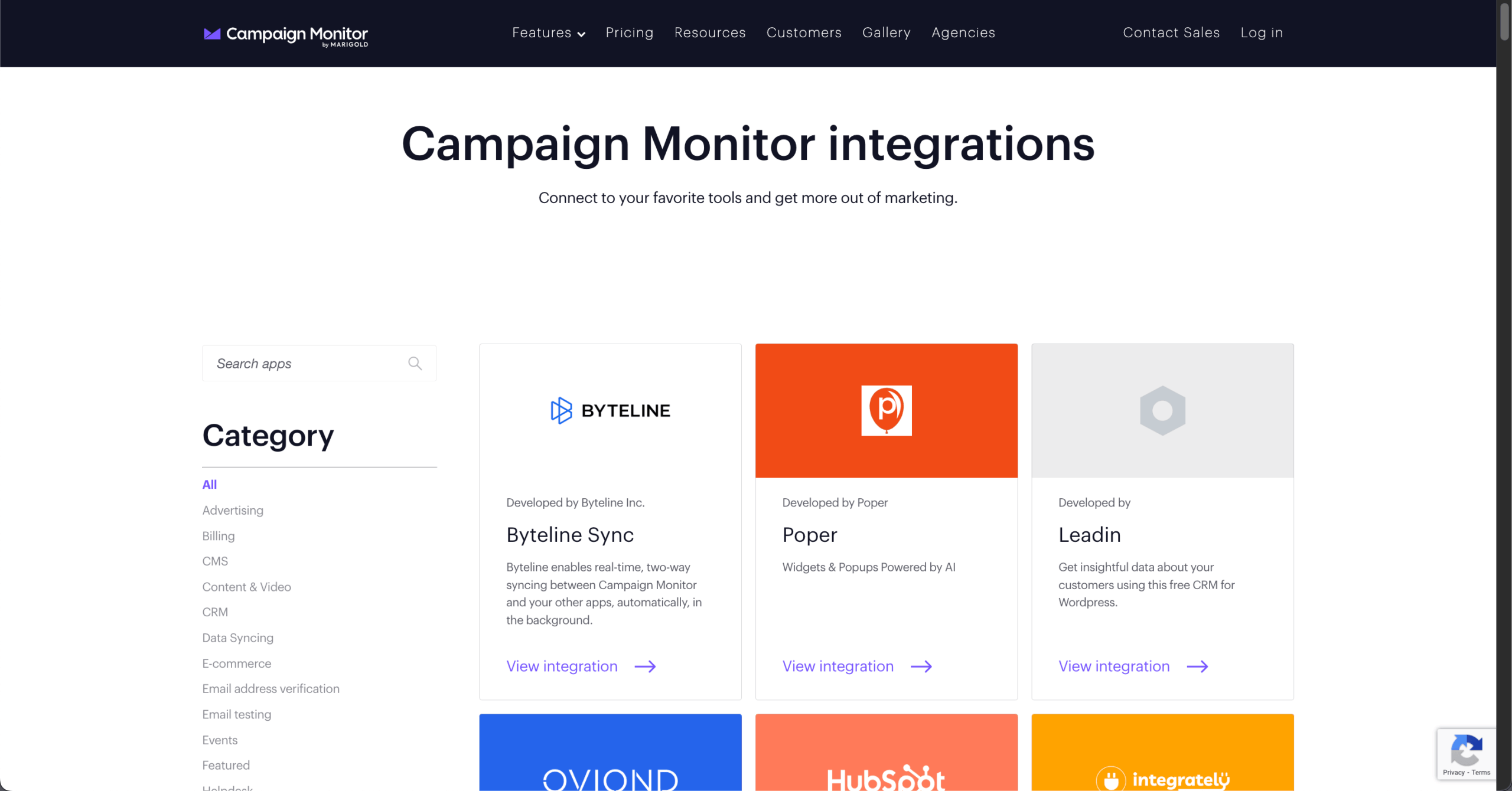
The REST API is comprehensive—lists, subscribers, segments, campaigns, templates, transactional emails. Webhooks keep external systems in sync when subscribers update or unsubscribe. You can export data in various formats, including PDF format for offline analysis.
One annoying limitation: you can’t edit automation journey steps via API. The workaround is updating the templates and segment triggers instead.
Reports go beyond basic email performance like opens and clicks with advanced reporting features. Click maps show exactly where people clicked (though only on actual links, not images). You can see breakdowns by email client, device type, and geography. Individual recipient activity can be exported or pulled via API for an in depth analysis.

The Insights dashboard aggregates the important metrics in a clutter free view—list growth, engagement trends, top-performing links. For automations, you see metrics at each step, making it easy to spot where people drop off. You’ll get regular reports on campaign performance automatically.
The dashboards aren’t customizable, and attribution modeling is basic. For serious analysis, I pull data via API into a proper analytics tool.
Support works through an in-app widget during business hours—6am to 5pm PT for Americas, similar windows for Europe and APAC. No 24/7 option unless you’re on the Premier plan. They also provide training videos to help you get started.
Phone support is Premier-only, and you’ll only see the number after logging in. The Unlimited plan gets you priority email support, which usually means faster responses. With higher tiers, you can send unlimited emails and manage an unlimited number of contacts.
The pricing structure clearly outlines what support level you get at each tier.
Basic
Unlimited
Premier
$9 / month
$29 / month
$149 / month
Up to 2,500 emails/month
Unlimited emails
Unlimited emails
Up to 500 subscribers (pricing scales with list size)
Up to 500 subscribers (pricing scales with list size)
Up to 500 subscribers (pricing scales with list size)
After bouncing between different platforms over the years, Campaign Monitor’s editor is refreshingly straightforward. No fighting with layouts, no mysterious breaks on mobile. The templates look modern without that cookie-cutter feel that screams “mass email”.
Building segments is intuitive—I can combine engagement data, location, purchase history, whatever I need, without feeling like I need a computer science degree. And the emails get delivered.
The Salesforce and Shopify integrations just work. When I’ve needed help, support has been genuinely helpful—not just copy-pasting from a knowledge base.
No free plan is a dealbreaker for some. You also can’t manage SMS campaigns directly—no SMS marketing features built in, which many competitors now offer. Sender includes SMS marketing in their standard plans, making it a more complete solution.
The automation builder, while easy to use, can’t match what ActiveCampaign offers. No complex branching logic, no lead scoring, no predictive sending unless you’re paying top dollar. A/B testing feels deliberately crippled on lower plans—you can test subject lines but not much else.
Template customization hits a wall fast if you don’t know HTML. The drag-and-drop builder is good, but for unique designs, you’re coding. And without CRM features or sales funnels, you’re definitely using this alongside other tools. The platform doesn’t support unlimited subscribers on basic plans either.
The API restrictions on lower tiers have forced clients to upgrade just to connect their custom apps.
Perfect Match For…
Look Elsewhere If You Need…
Small/Mid-Sized Businesses
The intuitive tools and reliable delivery work well without requiring a dedicated email team.
Enterprise Scale
You’ll miss the complex automation, extensive user roles, and deep CRM functionality larger operations require.
Design-Conscious Marketers
If aesthetics and branding matter, the template library and editing tools won’t disappoint.
Advanced Analytics
The reporting lacks comprehensive funnel tracking, attribution modeling, and detailed behavioral analysis.
Agency Teams
Managing multiple client accounts is straightforward with segmentation and reusable templates.
Bootstrapped Startups
The lack of a free plan and premium features may strain tight budgets.
During my Campaign Monitor review, I’ve found it fits best with small to mid-sized companies that care about design but don’t have email marketing specialists. It’s the right tool for teams that value aesthetics and simplicity.
Ecommerce brands love it—the templates work great for product showcases, and the Shopify integration is seamless. Agencies managing multiple clients appreciate the account structure and ability to maintain consistent branding while keeping everything separate.
If your tech stack includes Salesforce, WordPress, or any major ecommerce platform, Campaign Monitor slots right in.
You don’t need to read a whole Campaign Monitor review to understand that enterprises will hit walls quickly. The permission system lacks granularity, automation capabilities are capped too soon, and integration options for enterprise software are limited.
Bootstrapped startups and solopreneurs should look at Sender or Brevo’s free tiers. Campaign Monitor’s quality is worth paying for, but not if it means choosing between email marketing and eating.
Teams running complex, multi-channel campaigns with intricate logic flows will feel constrained. ActiveCampaign or Drip offer the automation depth Campaign Monitor lacks. Or consider Sender if you want similar capabilities without the premium pricing.
Most people really like Campaign Monitor for getting the job done without headaches. The templates look professional right out of the box, and sending campaigns is pretty straightforward. If you’re tech-savvy, you’ll appreciate the template flexibility and API options that let you build some seriously advanced stuff. Plus, their customer support actually helps when you need them, which is refreshing.
The biggest gripe? The interface can be a bit much when you’re trying to create fancy emails. If you’re not super technical, you might find yourself scratching your head and taking longer than expected to get things just right. But overall, people are happy with it—especially design teams and developers who don’t mind the learning curve.
Some people have been using Campaign Monitor since 2011 and are still happy customers—they love the quick responses, how support actually follows up on issues, and that everything just works without drama. When problems pop up, users say the support team is friendly and actually fixes things fast, which makes them feel confident about using it every day.
The main complaint is kind of specific: someone was frustrated they couldn’t completely delete a contact from their account. It’s not about email delivery problems or design issues—just this annoying limitation with managing contacts and cleaning up data.
Redditors generally like Campaign Monitor but they’re honest about its quirks. People say it’s easy to use for newsletters, they appreciate that new features roll out regularly, and it’s flexible enough to handle most automation needs. A few users specifically mentioned that the design tools are better than Mailchimp’s, which is a win if you care about your brand looking good or need multiple people working on campaigns together.
The builder does catch some heat though. Some users get frustrated with formatting issues and say it feels clunky when you’re trying to create something complex. You might have to dial back your ambitious designs or spend extra time double-checking everything looks right.
I’ve used Campaign Monitor across dozens of client accounts, and here’s the bottom line from this Campaign Monitor review: it does email marketing really well. The editor is intuitive, templates look professional, segmentation works without a manual, and emails land in inboxes reliably.
Yes, there’s no free plan. Yes, the automation could be more sophisticated. But for design-conscious businesses and agencies that want to send great-looking emails without the hassle, the $9/month starting price is reasonable. Though if budget matters more than polish, Sender gives you more features for less money.
Small to mid-sized companies that value presentation and ease of use will love it. If you need enterprise features, complex automation, or you’re bootstrapping on zero budget, look elsewhere. Campaign Monitor knows what it’s good at and doesn’t try to be everything to everyone.
Campaign Monitor vs Mailchimp
I’ve used both extensively. Campaign Monitor wins on design—better templates, cleaner interface, more polished overall. Mailchimp wins on features—ads, landing pages, basic CRM, deeper analytics.
Campaign Monitor is for brands that obsess over how their emails look. Mailchimp is for growth teams that want every marketing tool in one place. Pick based on what matters more to you.
Campaign Monitor vs Constant Contact
Campaign Monitor gives you better design control and more precise segmentation. Constant Contact throws in event management, social posting, and phone support.
My take: Campaign Monitor for marketers who know what they want. Constant Contact for small business owners who need hand-holding and extra features they might use someday.
Campaign Monitor vs Sender
This one’s not even close. Sender beats Campaign Monitor on features (built-in SMS, better automation), price (way cheaper at scale), and ecommerce capabilities.
Campaign Monitor’s templates might look slightly better, but Sender’s overall package is stronger. Unless you’re completely sold on Campaign Monitor’s interface, Sender is the smarter choice for most businesses.
Pretty customizable if you know what you’re doing. The drag-and-drop builder handles basic changes—colors, fonts, images, layout adjustments. For anything more complex, you’ll need HTML.
The template language supports repeatable sections, conditional content, and multiple layouts. Designers can lock down brand elements while giving marketers freedom to update content. Mobile controls for each section solve most responsive design headaches.
You can toggle tracking per link, and CSS gets inlined automatically. If you’re hand-coding, the system’s flexible enough. If you’re not technical, you’ll hit limits when you want something truly custom.
They do, but most businesses don’t need one. By default, you share IP pools with other senders. These pools are well-maintained, so deliverability is typically fine.
High-volume senders (we’re talking millions of emails monthly) can request a dedicated IP. You’ll need to prove you can maintain consistent volume and follow warm-up procedures. Once you have one, you control your sender reputation directly—which is great if you know what you’re doing, risky if you don’t.
The extra cost rarely justifies it for smaller senders. Focus on domain authentication and list hygiene first. Those matter more than whether your IP is shared or dedicated.
It’s built for agencies. Multiple client accounts under one login, white-labeling options, template sharing, granular permissions—all the agency essentials are there.
Small businesses can definitely use it successfully. The interface is approachable, automation covers basic needs, and you don’t need technical skills for everyday tasks. But they might outgrow it if they want integrated CRM, social media tools, or advanced marketing features.
Agencies get more value because they can spread the cost across clients and reuse templates and automations. Small businesses should weigh whether they need Campaign Monitor’s polish or if a cheaper alternative would work just as well.
